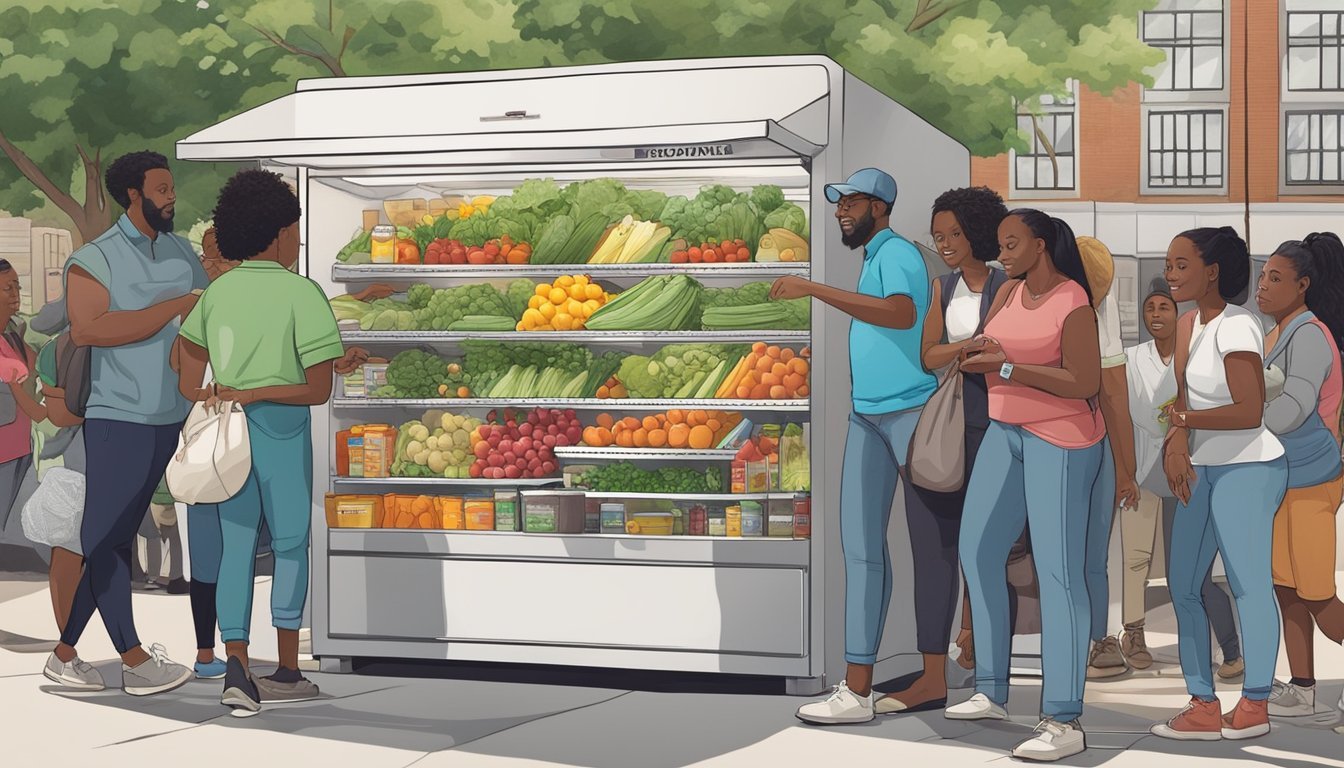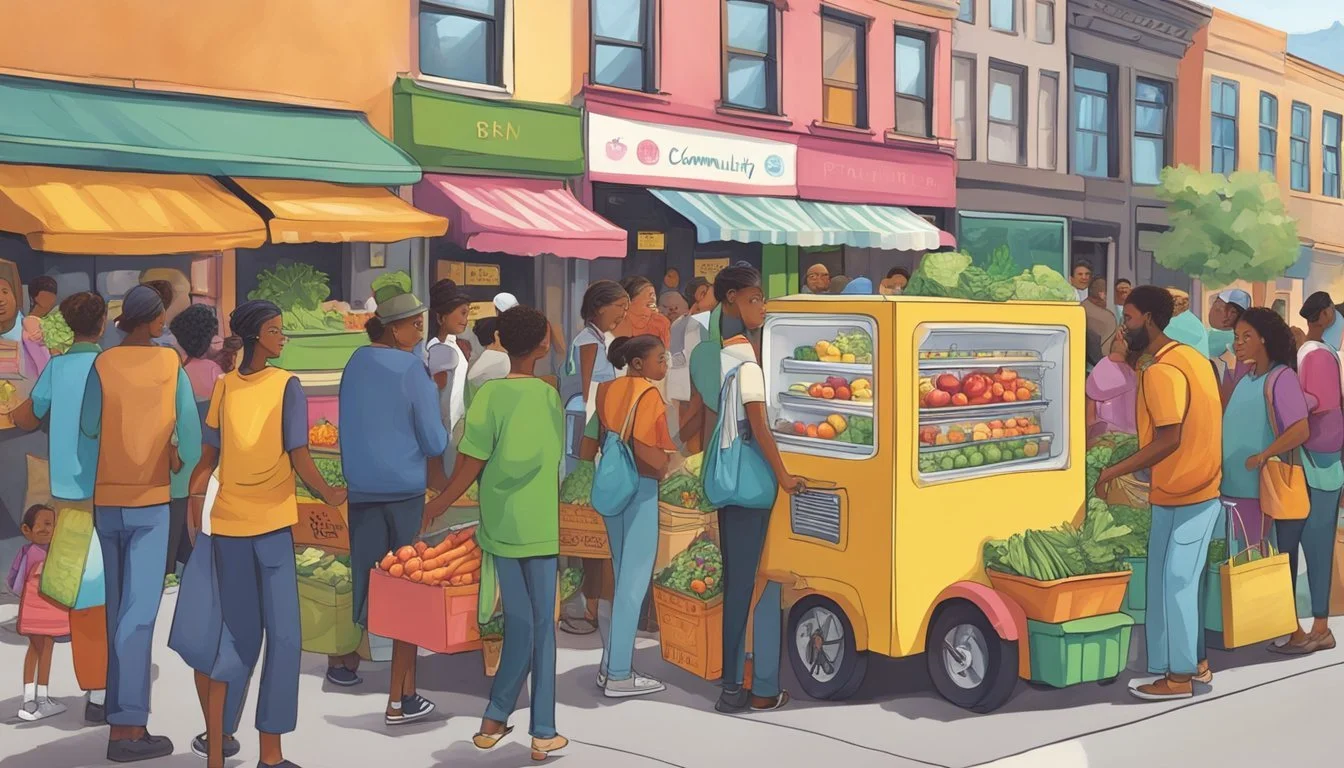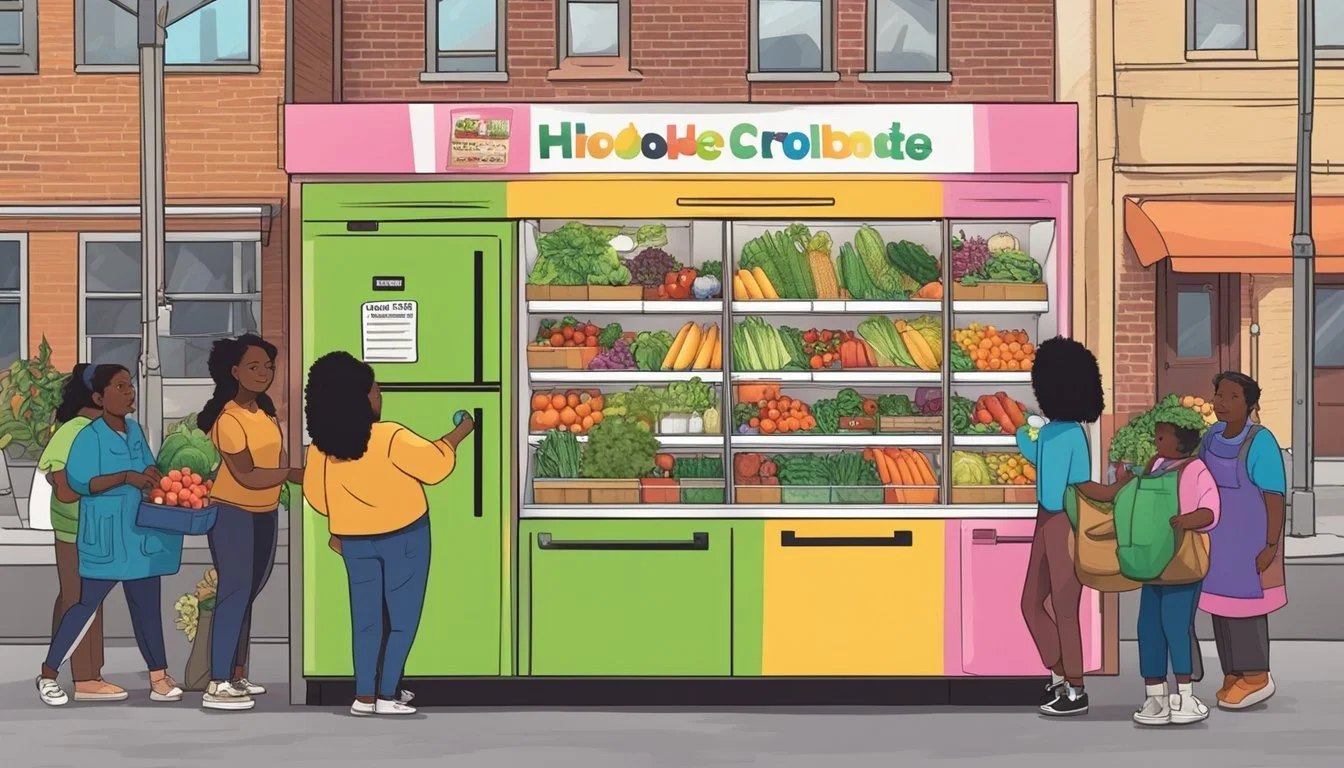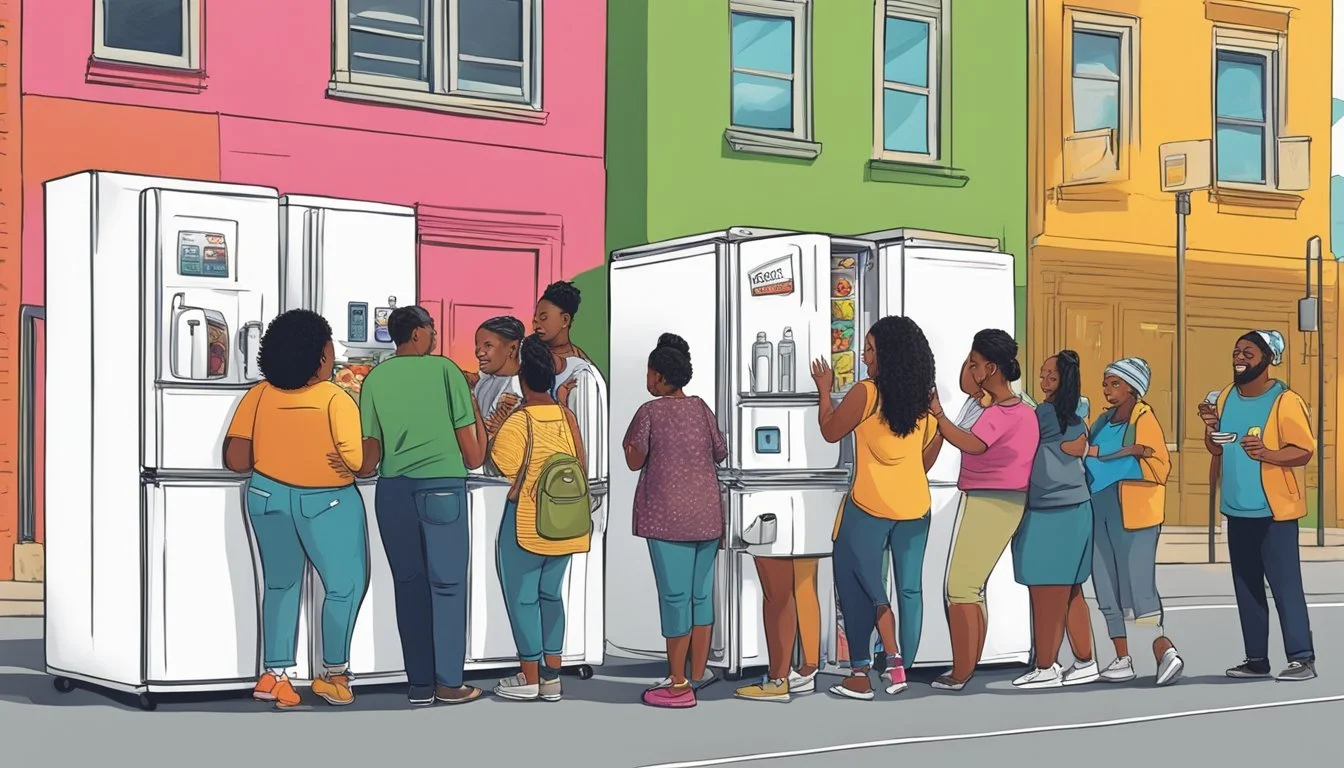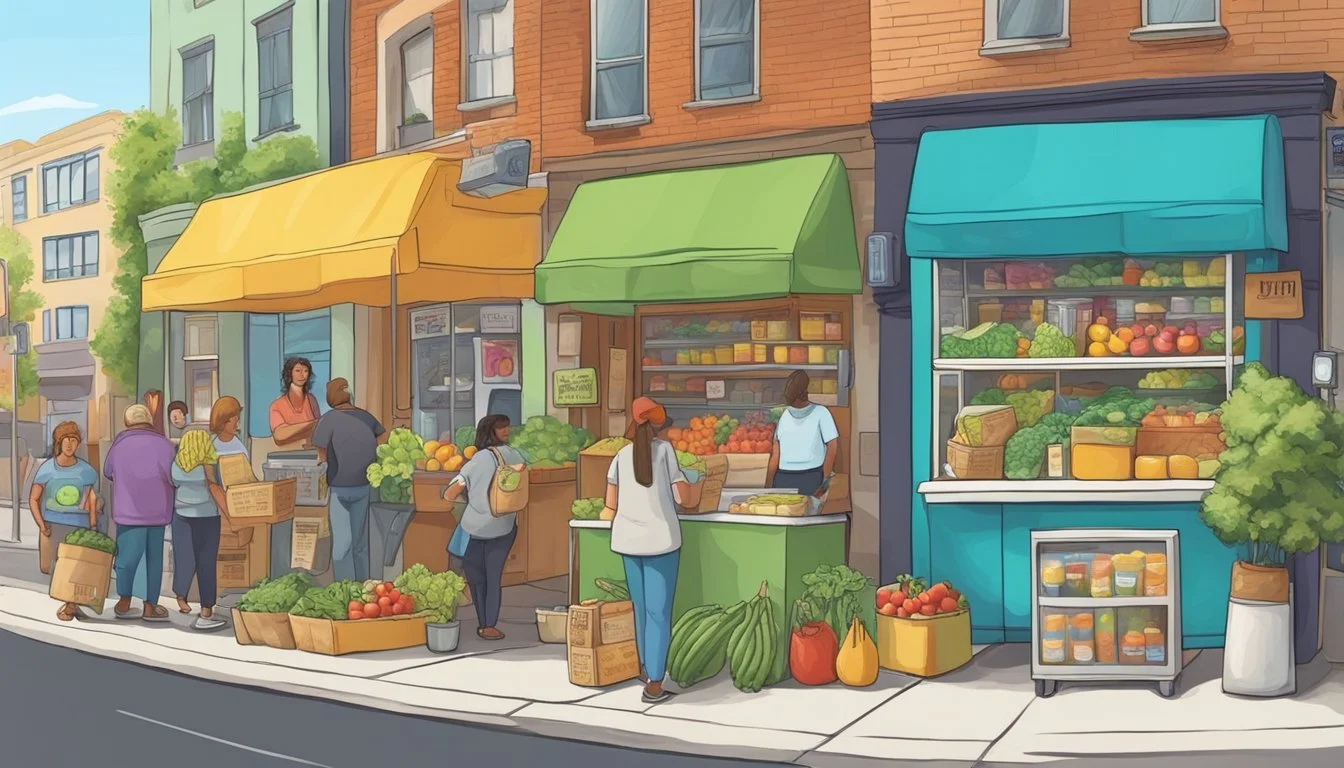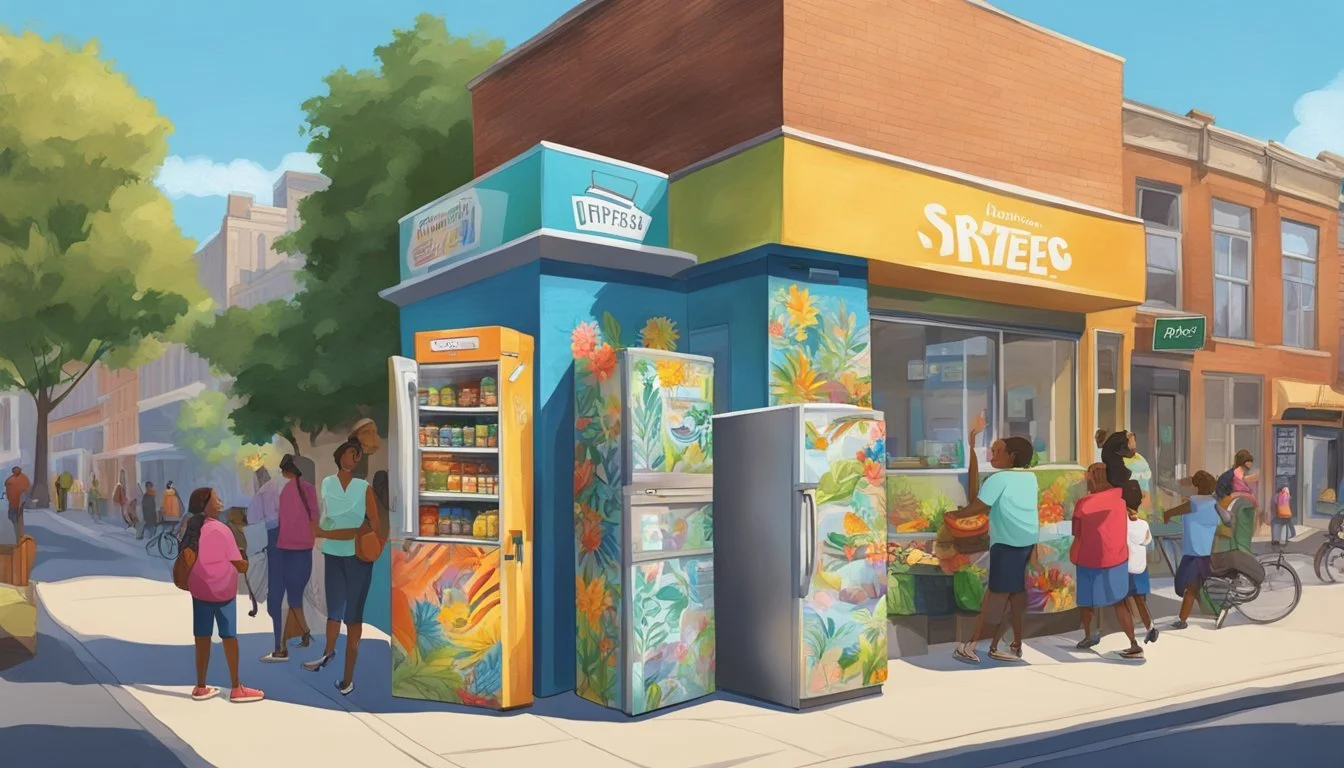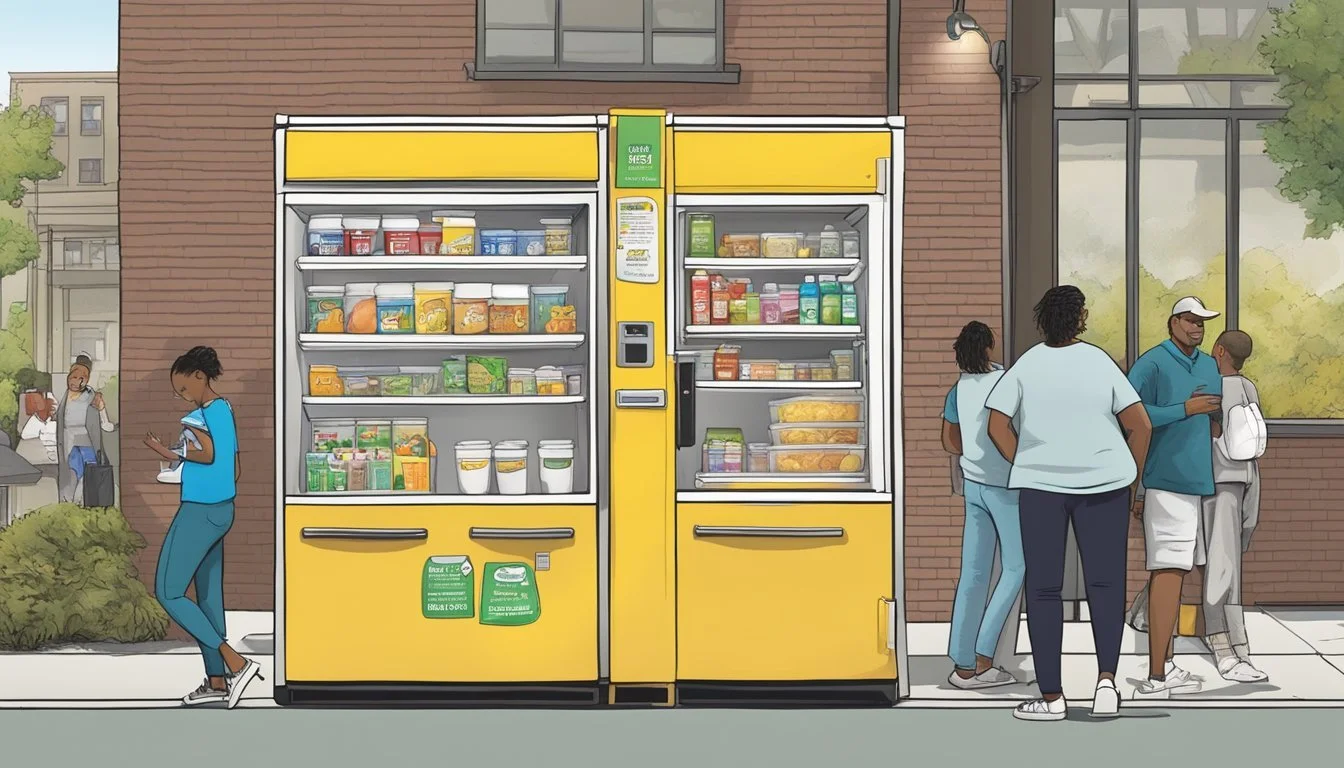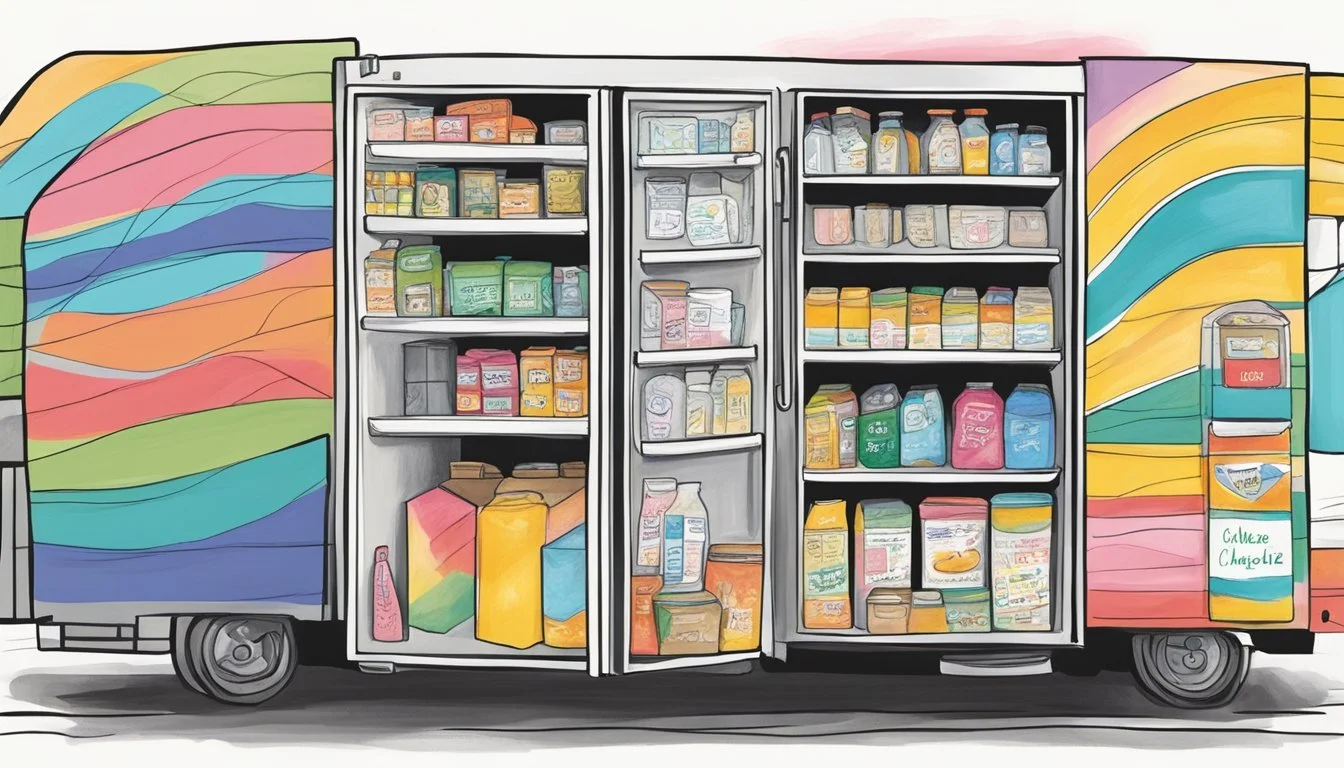Milwaukee, WI Community Fridge
Nourishing Neighborhoods through Share and Care
Milwaukee, Wisconsin, has embraced the community fridge concept, designed to combat food insecurity and reduce food waste within the city. These community fridges, essentially public refrigerators, are placed in accessible locations, allowing anyone to leave or take food as needed. The initiative operates on the principle of offering healthful food without the prerequisite of wealth, ensuring that all community members have access to nutritious options.
Local efforts such as the MKE Community Fridge facilitate a space open to the public around the clock. They operate with community support and hinge upon donor generosity, both in terms of food and funding. The fridges not only serve as a source of sustenance but also provide an avenue for people to contribute to their community's well-being, reflecting a larger movement toward mutual aid and sustainable living.
While the community fridge movement in Milwaukee has faced challenges, including the need for relocation and the coordination of safe and inclusive operations, the city has shown resilience and adaptability. Entities like No Hungry Homies Milwaukee and initiatives near West Side Partners illustrate the collaborative effort to establish and maintain such fridges. Each unveiling, like the inaugural fridge outside The Tandem Restaurant, signifies a step toward addressing food scarcity among Milwaukee residents and demonstrates the city's commitment to nurturing community networks.
Concept of Community Fridges
Community Fridges, an innovative approach to addressing food insecurity, operate on a simple premise: take what you need, and give what you can. These public refrigerators are strategically placed within communities to serve as a free food resource for residents.
A Community Fridge is more than just a storage appliance; it is a project founded on mutual aid and trust. People from all walks of life contribute to and benefit from these communal assets. They are regularly stocked with necessities like produce, dairy, and other perishable goods, ensuring that fresh food is accessible and safe for consumption.
Safety is a key consideration in the operation of Community Fridges. They are often connected with local organizations to maintain hygiene standards and food quality. The fridges are generally located in places that are easily accessible to both contributors and those in need.
To successfully manage a Community Fridge, community engagement is essential. Volunteers usually monitor the fridge to keep it clean and well-stocked. This model of community support not only combats hunger but also fosters community bonds and reduces food waste.
Key Components Purpose Free Access Reduce barriers to food availability. Public Contribution Encourage community sharing. Food Safety Maintenance Provide safe and hygienic options. Volunteer Supervision Ensure smooth operation.
Milwaukee's Community Fridge initiative exemplifies this concept, aiming to alleviate food insecurity by providing these resources in high-poverty areas. The fridges invite residents to participate in a collective effort to manage scarce resources more effectively and compassionately.
History of Milwaukee Community Fridge
The Milwaukee Community Fridge was established to address food insecurity in Milwaukee, providing free food to those in need. This initiative reflects a broader phenomenon of community fridges that have emerged across the United States.
Role of Pioneers
Milwaukee residents Hataya Johnson and Sarah Tramonte were instrumental in setting up the MKE Community Fridge. They were inspired by similar projects they saw, particularly from New York, to tackle hunger and poverty in Milwaukee. Their efforts included installing the fridge and maintaining it as a resource for the community. Through their dedication, Johnson and Tramonte provided an essential service to more than 100 people weekly during challenging times, such as the COVID-19 pandemic.
Expansion Over Time
As the project received positive community feedback, the MKE Community Fridge saw an expansion in its services. Initially located outside the Tandem restaurant on 19th Street and West Fond du Lac Avenue, it became Milwaukee's first public community fridge. Over time, this initiative confronted zoning issues and other regulatory challenges, but through community support and negotiations, it aimed to reopen and continue serving the public. The expansion of the MKE Community Fridge reflects a greater movement in the Great Lakes region, with community fridges popping up in cities like Madison, Chicago, Cleveland, and Toronto.
Locations and Accessibility
Community fridges in Milwaukee, WI offer easily accessible food options to the public. These fridges are strategically located in neighborhoods to maximize convenience for residents seeking food resources.
Finding a Community Fridge
Community fridges can be found in various neighborhoods across Milwaukee. Notably, the Near West Side Partners operates one at 624 North 24th St. Milwaukee, WI 53233, and another fridge is located near the corner of 19th & Fond Du Lac, outside the Tandem restaurant. Individuals looking for a fridge nearby can search online using phrases like "community fridge near me" or utilize apps and websites dedicated to mapping out food resources to pinpoint the nearest location.
Hours of Accessibility
The hours during which these community fridges are available may vary by location. Some fridges, particularly those outside establishments like restaurants, may be accessible 24/7, providing uninterrupted assistance. Others may have specific hours of operation and it is advised to check the corresponding websites or contact local organizers for the most accurate information. It is important to remember that accessibility might also be influenced by maintenance needs or restocking processes.
Benefits for the Milwaukee Community
Milwaukee's community fridge initiatives have been pivotal in addressing pressing social issues and fostering a sense of solidarity among residents.
Addressing Food Insecurity
In the heart of Milwaukee, community fridges serve as a beacon of hope for individuals grappling with food scarcity. These fridges, stocked with free food, alleviate the struggles faced by those living in food deserts where access to fresh and nutritious food is limited. By offering food without charge, the community fridges directly combat poverty and food insecurity, ensuring that the basic nutritional needs of Milwaukee's residents are met.
Strengthening Community Bonds
These community projects do more than just provide sustenance; they are instrumental in strengthening community bonds. The fridges foster a culture of sharing and support among neighbors, promoting communal responsibility and mutual aid. As residents both contribute to and benefit from the fridges, they cultivate relationships founded on generosity and compassion, cementing the communal ties that are vital for the city's resilience and collective well-being.
Donation Guidelines
When contributing to Milwaukee's Community Fridge, donors are encouraged to adhere strictly to the set guidelines to ensure the safety and efficiency of donations. These standards are in place to guarantee that the donated items are helpful, safe, and suitable for the individuals it serves.
What to Donate
Donors are invited to supply the fridges with a variety of items that cater specifically to the needs of those facing food insecurity. It is essential to focus on providing fresh produce and safe, uncontaminated food. The Milwaukee Community Fridge accepts:
Fresh fruits and vegetables: Ensure they are clean and ready to eat.
Packaged foods: Must be unopened and within their expiration date.
Beverages: Sealed, non-alcoholic drinks only.
Please note that homemade meals or perishable foods prepared at home are generally not accepted due to health and safety concerns.
Safety and Quality Control
Maintaining a high standard of safety and quality is paramount for food donations. The Milwaukee Community Fridge operates under specific rules to ensure that all:
Food items must be safe to consume, which means they should be stored at appropriate temperatures before donation.
Produce should be fresh; spoiled items are a health risk and are not accepted.
Containers ought to be sealed and intact, without any signs of tampering or damage.
Donors are responsible for assessing the quality of their donations, as the well-being of those who depend on the Community Fridge is the top priority.
Partnerships and Support
The Milwaukee Community Fridge initiative thrives on local collaborations that bolster its operations. Central to this network of support are local businesses and nonprofit organizations, which provide essential backing through various forms of partnerships.
Local Businesses
The Tandem Restaurant stands out as a prime example of local business support, where its owner, Caitlin Cullen, has played a significant role. This establishment demonstrates its commitment by not only contributing food but also by fostering a spirit of community engagement. Under Cullen's leadership, The Tandem serves as a hub that bridges the gap between excess food and those in need. This synergy is the result of dedicated efforts to counter food insecurity, where businesses like The Tandem actively participate in stocking and maintaining the fridges.
Business Contributor Type of Support The Tandem Restaurant Food donations and logistical assistance
Nonprofit Organizations
In the realm of nonprofit participation, entities work in concert to propel the mission of the Milwaukee Community Fridge forward. They partake by managing logistics, amplifying outreach, and providing a sustainable framework for the initiative's success. Nonprofit alliances are instrumental, ensuring there is consistent access to nutritious food, thereby making a measurable impact within the community.
Nonprofit Partner Role in Support Near West Side Partners Interviews & Awareness In Our Hearts Inspiration & Framework Adaptation
Nonprofit organizations contribute significantly by applying their expertise in community-building and resource management to bolster the communal network the fridges have established.
Volunteer Involvement
Community fridges in Milwaukee are powered by the dedication and hard work of volunteers. These individuals come from various walks of life but share a common goal: to give back to the community and ensure that no one in the city goes without food.
Volunteers are responsible for a range of tasks:
Monitoring and maintaining the fridges: They ensure the fridges are clean, running properly, and stocked with food.
Food collection and donation: They collect food donations from local businesses, markets, and individuals, then transport and arrange the items in the fridges.
The process of volunteering is organized and impactful. Those interested can:
Find a Local Fridge: Locate a community fridge in their neighborhood to support.
Get Involved: Reach out to local organizations or directly to the fridge coordinators to offer assistance.
Spread the Word: Educate others about the community fridge initiative and encourage more people to volunteer or donate.
Volunteer Activity Description Fridge Upkeep Regular cleaning and maintenance of the fridges. Food Collection Gathering and donating perishable and non-perishable food items. Community Outreach Engaging the neighborhood to raise awareness and involvement.
Volunteer involvement is integral to the survival of the community fridge movement. Their generosity helps combat food insecurity and support those in need within the Milwaukee area. The spirit of community giving is palpable among these selfless individuals who give their time, effort, and resources to this noble cause.
Impact of the Pandemic
During the COVID-19 pandemic, food insecurity magnified in Milwaukee, prompting grassroots initiatives such as community fridges to address the issue.
Rising Food Insecurity
The pandemic exacerbated pre-existing conditions of food scarcity. In Milwaukee, many individuals and families found it increasingly challenging to access nutritious food, with traditional support systems under strain. This surge in food insecurity was attributed to factors like job losses and school closures, which had previously provided steady meals for children in need.
The Response by Community Fridge
In response, the MKE Community Fridge emerged as a beacon of community-driven support. Organizers established this initiative to tackle food insecurity head-on by providing 24/7 access to free food. Located in accessible locations, these fridges allowed anyone in need to take food without barriers, ensuring a measure of food security during uncertain times. The movement also demonstrated the strength and resilience of the community in times of crisis.
Future Prospects and Projects
Milwaukee’s Community Fridge initiative is an ongoing project aimed at enhancing food security within the community. This effort dovetails with the city's broader agenda to address hunger and poverty.
The City of Milwaukee, known for its commitment to improving residents' well-being, encompasses projects that are both in action and in the pipeline. The focus is on expanding accessibility to fresh food through community fridges, strategically placed in neighborhoods such as Lindsay Heights and Johnsons Park.
A Look Ahead:
Expansion Plans: More fridges are planned, a push for inclusive growth.
Infrastructure Enhancements: Streets and neighborhoods are to receive upgrades to bolster Community Fridge access.
Future Projects include:
W. Lisbon Avenue development, potentially enhancing fridge reach.
Improvements on N. Prospect and N. Farwell avenues, proximity could benefit fridge visibility and usage.
Revitalization of W. Highland Boulevard and N. 35th Street, with prospective plans to incorporate food security initiatives.
The Community Perspective: They continually assess sites for new fridges, with a focus on areas showing greater needs. The project runs on a communal ethos—everyone has a stake, and everyone can contribute. Public infrastructure improvements are anticipated to facilitate smoother operations of fridge sites.
The Milwaukee Community Fridge Network aims to curate a sustainable model of mutual aid. The guiding principle remains that access to food is a right, not a privilege, and the network is dedicated to upholding this within the urban tapestry of Milwaukee.
How to Get Involved
Engagement in the Milwaukee Community Fridge initiative offers opportunities for both individuals and businesses to contribute to a socially impactful cause. This section describes the specific ways through which different actors in the community can play a part in supporting this effort.
Individual Contributions
Individuals wishing to support the Milwaukee Community Fridge can do so by:
Donating Food: They can contribute fresh produce, non-perishable items, and other food products that meet safety guidelines.
Volunteering Time: They can volunteer to monitor, clean, or stock the fridge. Interested individuals should connect with local organizers for schedules and guidelines.
Note: Donations should be made following the safety and guideline protocols provided by the community fridge organizers to ensure the well-being of all beneficiaries.
Business Partnerships
Local businesses can engage with the community fridge project through:
Food Donations: Establishments like restaurants, bakeries, and grocery stores can set up regular donation schedules for surplus food that is safe to consume.
Sponsorships: Businesses can offer financial support or donate equipment and supplies required for the operation and maintenance of the fridge.
Note: Partnerships must adhere to established food safety regulations and coordinate with community fridge representatives to maximize impact.
Educational Efforts and Awareness
The Milwaukee Community Fridge initiative actively focuses on educating the community about food insecurity and how to combat it. They offer a variety of programs and utilize different platforms to increase awareness.
Workshops and Events
Milwaukee's Community Fridge organizers conduct workshops and community events designed to educate individuals on the importance of food security and community support. These events serve as resources for learning about:
Nutritional information and food preparation
The impact of food deserts on local communities
How community fridges can alleviate hunger
Online Presence
Instagram plays a pivotal role in their online presence, where they regularly share updates about the fridge, success stories, and information about food donation and collection. Through their online channels, they reach a broad audience beyond Milwaukee, similar to efforts seen in New York City's community fridge movement. Their Instagram profile includes:
Updates on fridge stock and needs
Educational content on food sustainability
Community shoutouts and partnership announcements
Through these subsections, Milwaukee Community Fridge reinforces its commitment to not only providing resources but also building a well-informed community network.
Profiles of Key Figures
In Milwaukee, the Community Fridge initiative has been significantly shaped by the dedicated efforts of individuals like Hataya Johnson and Caitlin Cullen. Their contributions have fostered a network of support within the community, striving to alleviate hunger and reduce food waste.
Hataya Johnson's Contributions
Hataya Johnson has been a vital force in the fight against hunger in Milwaukee's neighborhoods. She is one of the pioneering figures responsible for setting up the Milwaukee Community Fridge. Johnson's vision was to create a system where access to healthy food was a reliable option for residents, particularly in times of need. Her work entails coordinating with local organizations, ensuring the fridge is stocked, and maintaining its accessibility to the public.
Caitlin Cullen's Initiatives
Caitlin Cullen, the owner of The Tandem restaurant, has played a significant role in facilitating the Community Fridge outside her establishment. Cullen has focused on coupling the fight against food scarcity with the reduction of waste. By providing space and support for the refrigerator right outside her restaurant located at 19th Street and West Fond du Lac, she has created a hub for community sharing and caring. Cullen's initiatives reflect an inclusive ethos, aimed at achieving an impactful and safe way to support the local community.
Comparison with Other Cities
Milwaukee's Community Fridge initiative is a local response to broader trends in urban food insecurity and waste reduction. This effort reflects a common theme seen in major cities, though its implementation varies by location.
Farmer's Fridge in New York City
New York City made waves in 2020 when its community fridge movement garnered significant attention online. In particular, Farmer's Fridge stands out for its innovative approach. These are not ordinary community fridges; they are high-tech vending machines that provide fresh salads and snacks. While both Milwaukee and New York City aim to combat food insecurity, New York's Farmer's Fridge brings a commercial twist to the access of fresh food, positioning these fridges in high foot traffic areas for convenience.
World Central Kitchen's Role
Conversely, the non-profit organization World Central Kitchen plays a substantial role in addressing food insecurity on a larger scale, often stepping in during crises worldwide. They provide meals in response to natural disasters, pandemics, and other emergencies. Though not directly linked to Milwaukee's Community Fridge, World Central Kitchen's efforts highlight the importance of community and charitable responses to hunger, resonating with the same spirit that fuels local community fridge initiatives.
Milwaukee's approach centers on providing free food directly to passersby through fridges connected to community organizations, representing a hands-on, mutual aid solution that echoes the core mission of entities like World Central Kitchen.
Feedback and Community Reviews
The Milwaukee Community Fridge receives feedback and reviews primarily through social media platforms, reflecting robust community engagement in support of its mission to alleviate hunger.
The Role of Social Media
Social media serves as a critical channel for the Milwaukee Community Fridge, where it garners opinions and feedback on its operations. Facebook, for instance, showcases numerous likes and commentary from individuals who support the idea of accessible food for all, underscoring a positive sentiment towards the initiative's social impact. Similarly, Instagram acts as a visual storytelling platform where images of stocked fridges and grateful recipients illustrate the direct benefits provided to the community.
Community Engagement
Community support for the Milwaukee Community Fridge is evident from the mobilization of volunteers and the spreading of information through word-of-mouth and online platforms. Review sites like Yelp also contribute to this engagement by providing a space for individuals to leave reviews, though specific feedback through Yelp may be limited. The community's participation is further highlighted by the prompt and enthusiastic response to calls for finding a new home for the fridge when needed, showcasing a strong local commitment to the project.
Challenges and Limitations
The Milwaukee Community Fridge initiative is a grassroots effort to tackle food insecurity and poverty through mutual aid. Community fridges are set up in public spaces, providing free food to those in need. Despite its noble intent and benefits, the program faces a number of challenges and limitations.
One significant issue is vandalism. Fridges placed on city sidewalks are vulnerable to criminal activities. Volunteers who maintain these fridges often have to deal with damage or destruction, which can impede the fridge's operation and the safety of food items.
Regulatory challenges pose another hurdle. Community fridges operate in a grey area of city ordinances. Zoning laws can conflict with the location and operation of these fridges, leading to notices from zoning departments to move or remove the fridges, thus disrupting their efforts to provide consistent access to food.
The pandemic heightened the role of community fridges as a lifeline for many facing unemployment. However, it has also increased the demand for food aid, straining the capacity of the community fridges and revealing the vast scale of food insecurity challenges in urban settings.
The Milwaukee project operates in a landscape impacted by poverty. While Community Fridges are a step towards food security, they are a temporary solution to a complex, systemic problem, which requires comprehensive policies and longer-term strategies for poverty alleviation.
Conclusion
Milwaukee has witnessed a positive community response with the establishment of the MKE Community Fridge. These fridges offer free access to food, providing vital support in addressing food insecurity within the city. Local organizers and volunteers maintain the fridges, reflecting a powerful example of mutual aid in action.
The Tandem Restaurant hosted the first community fridge, setting a precedent for others to follow. The project aims to expand, with additional fridges across Milwaukee to increase food accessibility. Such initiatives display the community's commitment to supporting those in need, especially during times of economic difficulty.
The success of the community fridge movement largely depends on continued community involvement, donations, and responsible usage. This ensures the sustainability and effectiveness of these resources in the long term. With Milwaukee facing the challenge of food deserts, the community fridges stand as beacons of hope, working to alleviate this issue.
Future prospects look promising as awareness grows and more residents participate. The community fridges hold potential not only in providing food but also in fostering a spirit of collaboration among Milwaukee's residents. They are more than just food sources; they are symbols of the collective effort to support and uplift one another within the community.

